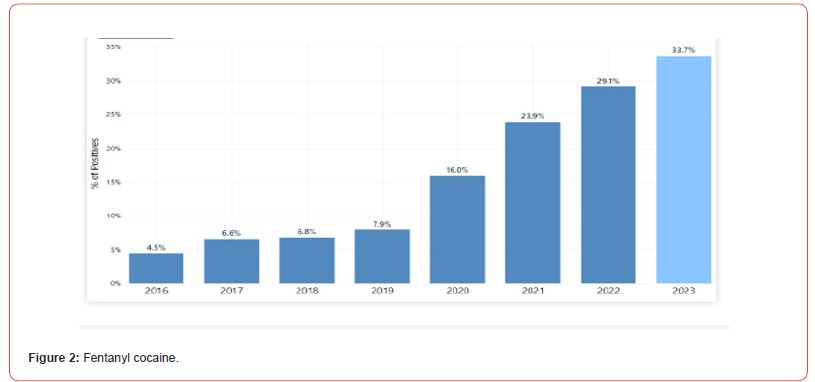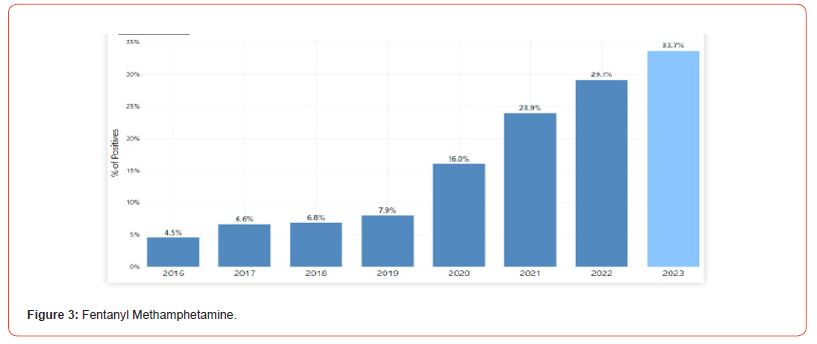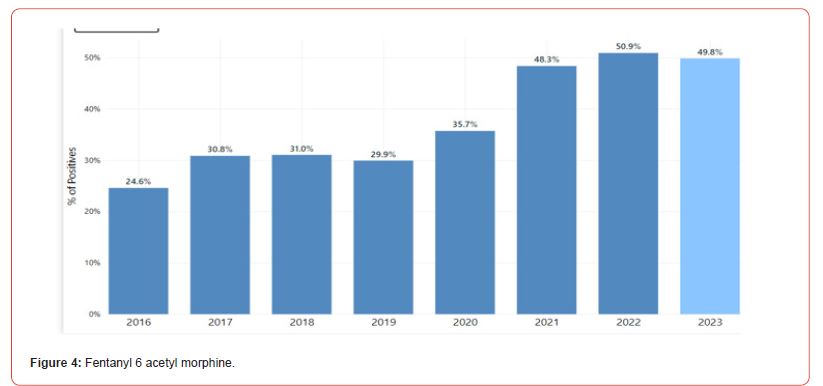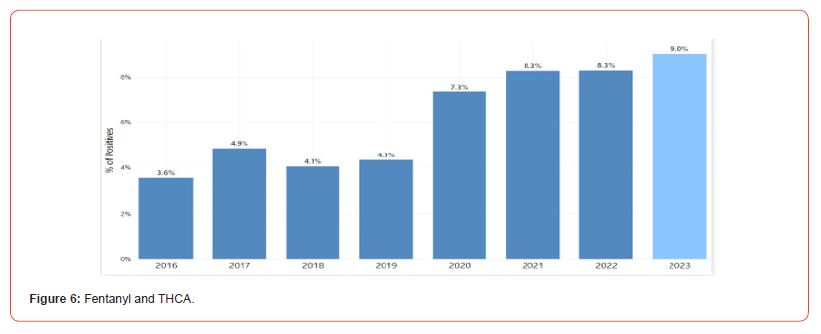 Research Article
Research Article
Update2: Correlation Of Fentanyl Positive Drug Screens with Other Illicit Drugs in Patients from Pain, Rehabilitation and Behavioral Programs
Amadeo J Pesce*, Keith Tran, Richard Thomas, Greg Ackerman and Kevin Krock
Precision Diagnostics LLC, San Diego, CA, USA
Amadeo J Pesce, Professor, Precision Diagnostics LLC, 4215, Sorrento Valley Boulevard, San Diego, CA 92121, United States.
Received Date: November 03, 2023; Published Date: November 28, 2023
Abstract
Objective: To monitor polydrug substance abuse over past eight years.
Method: Calculate percent of fentanyl and other drugs positive in urine drug tests.
Results: Percent of fentanyl positive drug tests increased, but increases in fentanyl/cocaine, fentanyl/methamphetamine, fentanyl/6acetylmorphine and fentanyl/marijuana were observed. The incidence of oxycodone laced with fentanyl did not increase.
Conclusion: Poly substance abuse of illicit drugs over time is increasing.
Introduction
The National Center for drug abuse statistics indicated an increase in drug overdose deaths during the past few years. They reported 96,779 drug overdose deaths from March 2020 to March 2021 [1]. This was a considerable increase compared to earlier compilations. In part these overdoses were ascribed to the presence of fentanyl at the time of death. However, our drug test data indicated that in many of our patients we have observed that more than one illicit drug was present along with fentanyl [2,3]. We considered that polysubstance abuse could be contributing to the increased overdose deaths. For example, in one newspaper article, it was noted that 6 army cadets were overdosed on fentanyl laced cocaine [4]. The CDC has warned that fentanyl has been found in a variety of products [1-9].
We had published our findings on the incidence of fentanyl laced in cocaine (benzoylecgonine), 6-monoacetyl morphine (heroin), methamphetamine, THCA, and oxycodone as of the year 2019 [6]. Using the more than 3.5 million drug tests performed from 2016 to 2023, we were able to track the incidence of fentanyl in other illicit drug positive tests in these test urines to establish if polydrug abuse had increased in the past few years. In addition, we examined patients prescribed methadone or buprenorphine treatment for substance abuse who also used fentanyl.
Materials and Methods
From April 1, 2016, to July 31, 2023 we performed comprehensive drug tests on 3,706,299 urine specimens submitted by pain, addiction treatment, and behavioral clinics across the United States. The study was approved by WCG IRB Puyallup, WA. The method of analysis has been described by Krock, K, et al. [6]. The cutoff for defining a positive test was the same over all eight years.
The de-identified data for positive morphine- fentanyl, 6-monoacetylmorphine (6-MAM)-fentanyl, benzoylecgoninefentanyl, methamphetamine-fentanyl-methadone-fentanyl, buprenorphine-fentanyl, and 11-Nor-9-carboxy-Δ9- tetrahydrocannabinol (THC-A)-fentanyl was extracted. The percentages per yearly period were determined for results indicating the prevalence of fentanyl positive in the presence these drugs. The data from the LC-MS/MS instruments was downloaded from the Indigo ASCENDTM software into an Excel file which was then visualized using Microsoft Power BITM software [8]. We calculated the mean values for the test drug, fentanyl and percent co-drug positive as well as the standard deviation for these parameters.
Results
Based on >3million test results. We examined the correlation between fentanyl and the drugs, cocaine (benzoylecgonine), methamphetamine, 6 monoacetyl morphine (heroin), marijuana, (THCA) and oxycodone over the years 2016 to 2023.
The presence of fentanyl as a percent of specimens tested is shown in Figure 1 & Table 1. There was a definite increase in the years from 2016 to 2023. The polypharmacy of fentanyl with other drugs posted an increase of polysubstance abuse, with benzoylecgonine, methamphetamine, 6-MAM, oxycodone and THCA. These are expressed in Figures 2-6 and the associated Tables 2-6. From April 2016 to July 2023, we found a yearly percent increased combination fentanyl and benzoylecgonine (cocaine) which ranged from 6.8% in 2016 to 29.8% in 2023 (Figure 2 & Table 2). There was also a large increase in the percent positive fentanyl in methamphetamine positive specimens (Figure 3 & Table 3). These went from about 4.5% to about 33% in this time frame. The fentanyl positivity in the 6-MAM data increased from about 25% in 2016 to 50% in 2023 (Figure 4 & Table 4).
There was little change in the percent of fentanyl in oxycodone positive specimens (Figure 5 & Table 5). These ranged around 4% 14%. However, there was a large increase in fentanyl positives in those specimens positive for THCA (Figure 6 & Table 6). This went from about 3.6% to about 9%.
Table 1:Fentanyl positives.

Table 2:Fentanyl cocaine.

Table 3:Fentanyl Methamphetamine.

Table 4:Fentanyl 6 acetyl morphine.

Table 5:Fentanyl oxycodone.

Table 6:Fentanyl and THCA.







Discussion
Over the past 8 years, we have examined more than 3 million specimens from an at-risk population. This work describes an update of our observations on the incidence of fentanyl in our urine specimens.
Newspaper articles have claimed there is a major increase of its use and increased presence in illicit and “prescription drugs” obtained on the street [13]. We observed a large percent increase in fentanyl in those specimens positive for benzoylecgonine, methamphetamine and THCA. The percentage of heroin positive for fentanyl increased from 2016 but appears to have levelled off in recent years. However, about 50% of the 6 acetyl morphine specimens contained fentanyl. This was the highest percentage of the combination of an illicit drug with fentanyl.
The patients on medication treatment for substance abuse also showed an increase in polysubstance abuse. Those treated with methadone more likely to also be abusing fentanyl.
This study is limited as specimens are derived from our monitored population and may not be applicable to a more general population.
Acknowledgement
All the authors are employees of Precision Diagnostics LLC.
Conflict of Interest
There are no conflicts of interest.
References
- Halfway House Directory (2023) Fentanyl is everywhere.
- Peckham A, Villines Z (2023) What to know about fentanyl-laced cannabis. Medical News Today.
- Lewis C (2021) Overdoses Involving Cocaine and Fentanyl Are on The Rise. NPR.
- Joshua Rhett Miller (2022) Six West Point spring breakers OD on fentanyl-laced cocaine in Florida. Nypost.Com.
- Krock K, Nickley J, Tran K, Thomas R, Ackerman G, et al. (2020) Correlation of Fentanyl Positive Drug Screens with Other Medications in Patients from Pain, Rehabilitation and Behavioral Programs. Ann Clin Lab Sci 50(2): 260-265.
- Krock K, Pesce A, Ritz D, Thomas R, Cua A, et al. (2017) Lower Cutoff for LC-MS/MS Urine Drug Testing Indicates Better Patient Compliance. Pain Physician 20(7): E1107-E1113.
- Villamizar M (2021) Fentanyl is making its way into various drugs sold in the U.S. Here’s how it gets there. PBS News Hour.
- Vigdor N (2021) D.E.A. Warns of ‘Alarming’ Increase in Fentanyl-Laced Fake Pills. NY Times.
- Pesce AJ, Chandler N, Ackerman G (2021) Information Technology Structure for Urine Drug Testing Reports. 21st Century Pathol 1(1): 1-9.
- Pesce A, Sundyhanata R, Ritz D, Thomas R, Ackerman G, et al, (2021) Effects of a Pandemic and Isolation on Alcohol and Psychoactive Medication Use in a Population of Rehabilitation and Pain Patients. Ann Clin Lab Sci 51(5): 694-697.
- Pesce A, Krock K, Nickley J, Tran K, Thomas R, et al. (2022) Correlation of Fentanyl Positive Drug Screens with other Medications in Patients from Pain, Rehabilitation and Behavioral Programs. Ann Clin Lab Sci 52(2): 825-830.
- Pesce A, Tran K, Thomas R, Ackerman G, Krock K (2022) Update: Correlation of Fentanyl Positive Drug Screens with other Medications in Patients from Pain, Rehabilitation and Behavioral Programs. Ann Clin Lab Sci 52(5): 825-830.
- (2023) Drug Overdose Death Rates. NCDAS National Center for Drug Abuse Statistics.
-
Amadeo J Pesce*, Keith Tran, Richard Thomas, Greg Ackerman and Kevin Krock. Update2: Correlation Of Fentanyl Positive Drug Screens with Other Illicit Drugs in Patients from Pain, Rehabilitation and Behavioral Programs. Open Access J Addict & Psychol 7(4): 2023. OAJAP.MS.ID.000669.
Pain patients; Drug therapy; Urine drug testing; Drugs; Pain medications; Rehabilitation centers; Pain/ortho; Pain management; Primary care pain; Internal medicine; Primary family medicine; Pain orthopedics; Physical medicine; Sports medicine
-

This work is licensed under a Creative Commons Attribution-NonCommercial 4.0 International License.






